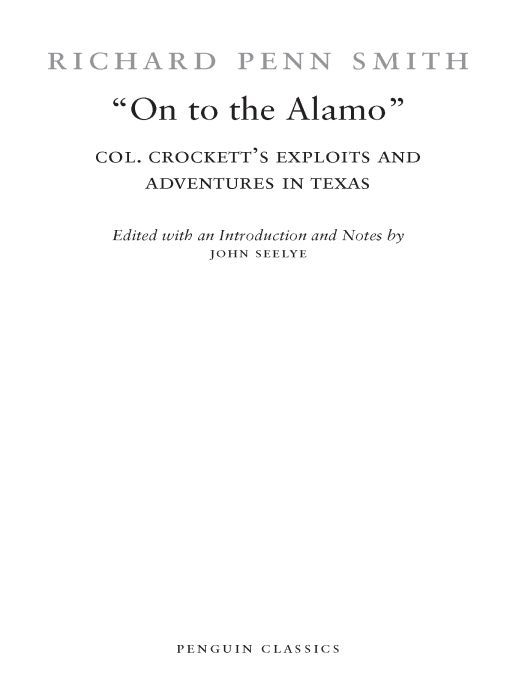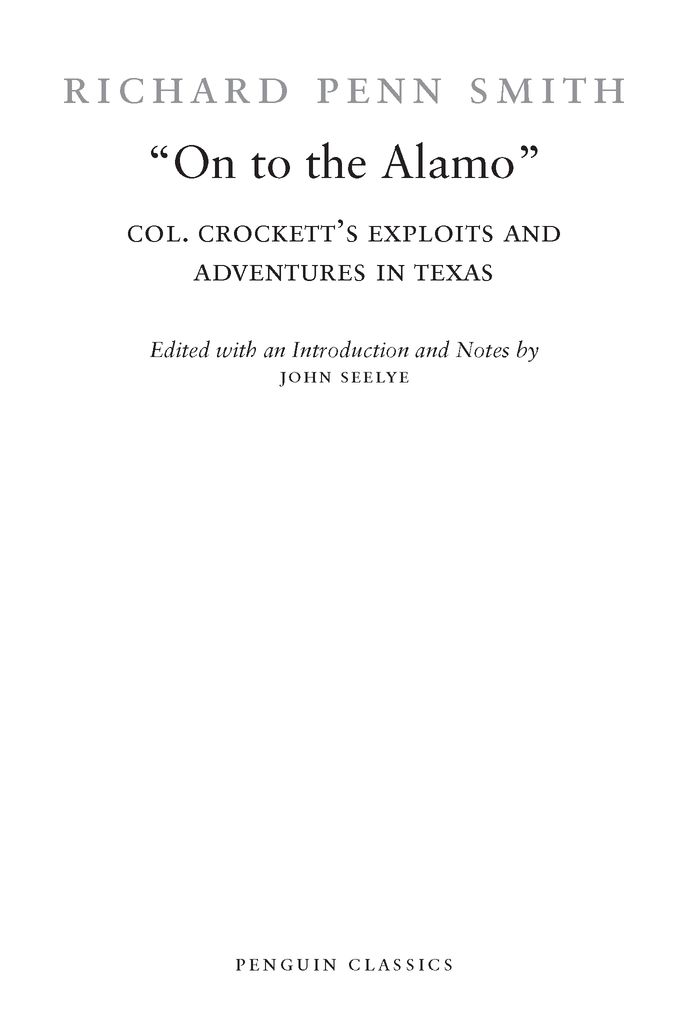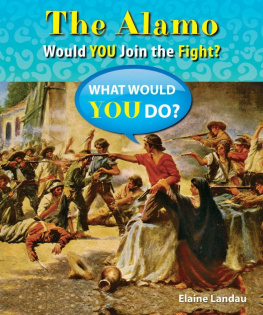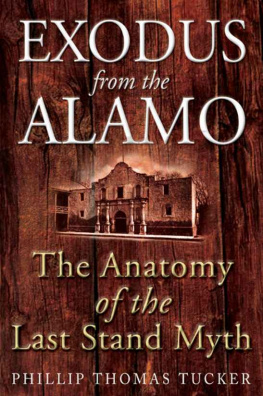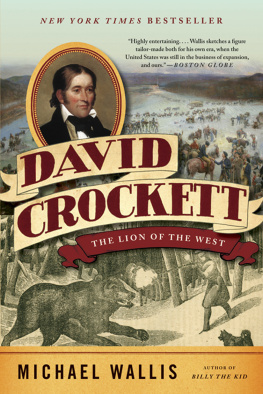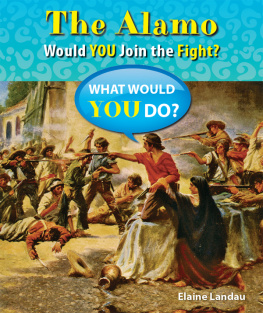Table of Contents
ON TO THE ALAMO
COL. CROCKETTS EXPLOITS AND ADVENTURES IN TEXAS
DAVID (a.k.a Davy) CROCKETT was born in Tennessee in 1786 and was raised in frontier country, suffering much hardship during his early years. As a young man he served under Andrew Jackson during the Creek War (1814) and soon began establishing a reputation as a mighty hunter and a teller of even mightier tales. These qualities, along with quick wit and considerable charisma, led to his election to the Tennessee legislature (1821) and then in 1827 to the U.S. House of Representatives, where he was an advocate for the frontiersmen of western Tennessee until defeated for reelection in 1835. Elected as a Jacksonian Democrat, he soon began to differ with the president on a number of issues and by the end of his career had drifted toward positions held by the Whig Party. Early on, the rough-hewn congressman began to call public attention to himself through his humorous remarks and tall tales; by 1830 he had inspired a popular theatrical farce and shortly thereafter collaborated on several autobiographical works, including the well-known A Narrative of the Life of David Crockett (1834).
Out of office and suffering from financial reverses, Crockett headed for Texas in 1836, hoping to buy land to which he could relocate his wife and children. But his plans were changed by the armed revolt of other American emigrants who hoped to throw off Mexican rule and establish an independent republic. Crockett joined the small garrison at the Alamo in San Antonio, where he gained a further measure of fame as a martyr to the cause of Texan freedom, dying a heroic death at the hands of the attacking Mexican Army led by President Santa Anna.
JOHN SEELYE is a Graduate Research Professor of American Literature at the University of Florida. He is the author of two novels and a number of books dealing with American culture from the colonial period to the twentieth century. He has written several essays on the mythic Davy Crockett, devoted to separating fact from fiction. He serves as consulting editor of the Penguin Classics.
For Ham Hill
Introduction
I.
It has been more than sixty years since Walter Blair, the distinguished scholar of American humor and folklore, established that there were at least six Davy Crocketts. They ranged from the Democratic congressman from Tennessee who set himself in opposition to the policies of President Andrew Jackson to the mythic hero of comic almanacs published in the 1830s and 40s, a figure essential to the tradition of southwestern humor that was brought to a fine art by Mark Twain. But perhaps the most enduring of the Crocketts has been the martyr-hero of the Alamo, who, with the other defenders of the fort in San Antonio, was killed in 1836 by the army commanded by General Santa Anna, president of Mexico. Texas was then Mexican territory, and Santa Anna was attempting to drive out American colonists because they were planning to establish a republic independent of his tyrannical rule.
And if there were six Crocketts then it must be said that five died defending the Alamo: the one who was shot and killed early in the battle as he crossed the forts parade ground, the one who fell surrounded by the bodies of the Mexican soldiers he had killed, the one captured and executed with four other Americans on the orders of Santa Anna, the one who tried to escape that fate by claiming immunity through virtue of his status as a U.S. congressman, and the one who, on being sentenced to die, attempted to assassinate Santa Anna before being killed by the generals men.
The preferred version deep in the hearts of Texans is the second, and indeed it was the one reported firsthand by the two survivors of the massacre at the Alamo: Mrs. Susanna Dickinson, widow of a gunnery officer slain in the battle, and a slave named Joe, the servant of Colonel William B. Travis, who died while commanding the defense of the fort. The alternative versions may be traced to Mexican and other sources, some of dubious authority, many recounted well after the fact. Moreover, it must be said that the stories told by Mrs. Dickinson and Joe were filtered through a journalistic sieve. In short, the manner of Colonel Crocketts death will never be known, but none of the contradictory accounts deny him his heroic stature, not even the story of his attempt to bluff his way to freedom, which is the kind of brass that passes for gold in Texas.
The point to be made is that the fame of Davy Crockett is inseparable from the name of the Alamo, and will last so long as the other endures in the national memory. The Alamo, wrote the journalist Richard Harding Davis in 1892, is to the South-west what Independence Hall is to the United States, and Bunker Hill to the East; but the pride of it belongs to every American, whether he lives in Texas or in Maine (Davis: 17). The occasion of this remark was Daviss visit to San Antonio, and the irony of it is that, according to Daviss biographer, Arthur Lubow, the reporter had only recently learned about the Alamo. At a dinner party in New York given by Theodore Roosevelt, then a young civil service commissioner, the host was politely but firmly indignant when his guest admitted his ignorance regarding that sacred site in Texas. TR forthwith informed Davis of the history of the Alamo, which the reporter dutifully included early in his account of his western travels.
Roosevelt in 1892 had only just begun his political career, which would be given a considerable boost by his role in the Spanish-American War, thanks in large part to the account of the fight for San Juan Hill written by Richard Harding Davis, but he was already associated with the American West in the minds, if not the hearts, of his fellow Americans. Roosevelt had written books about his adventures as a ranchman in North Dakota and the first two volumes of his Winning of the West had been published in 1889. More to the point, in 1895 he would write, in collaboration with his friend Henry Cabot Lodge, Hero Tales from American History.
This was a book intended for young Americans, containing the stories of some Americans who showed that they knew how to live and how to die; who proved their truth by their endeavor, and who joined to the stern and manly qualities which are essential to the well being of a masterful race the virtues of gentleness, of patriotism, and of lofty adherence to an ideal (xxiii). This jingoistic, chauvinistic collection was in many ways a prolegomenon to the forthcoming war with Spain, and among Roosevelts contributions was an essay titled Remember the Alamo, the famous slogan that soon enough would be updated to Remember the Maine.
The hero who emerges from Roosevelts account of the Alamo siege was predictably Davy Crockett, who was the last man left standing: wounded in a dozen places, he faced his foes with his back to the wall, ringed around by the bodies of the men he had slain (86). But as Mexican lancers held him at bay, weakened by wounds and loss of blood, he was helpless against soldiers with carbines who shot him down. Some say, added Roosevelt, that when Crockett fell from his wounds, he was taken alive and was then shot by Santa Annas order; but his fate cannot be told with certainty, for not a single American was left alive. At any rate, after Crockett fell the fight was over. Every one of the hardy men who had held the Alamo lay still in death. Yet they died well avenged, four times their number fell at their hands in the battle (87).

